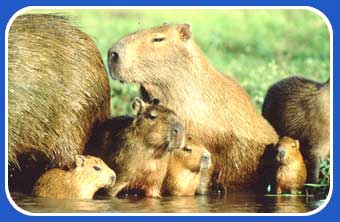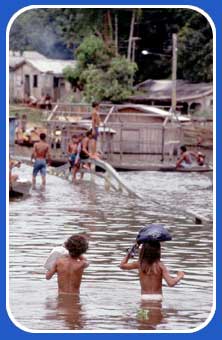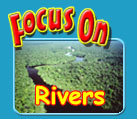|
|

|
|
|
|
| |
|
|
|
|
| |
 |
We
don't just use rivers for drinking water.
Make a list of other ways in which people
use rivers � |
| How many uses
could you think of? Have a look at the picture
and roll your cursor over it to find out some
ways in which people use rivers.Click on them
to find out more. Did you think of all these? |
 |
 |
Some of the ways
in which people use water can harm a river's
natural environment, others do not. Which
of the uses shown in the picture are harmful
to the river environment? Which ones are not? |
| Are there any
uses that are difficult to decide whether
they are harmless or harmful to the river
environment? Why do you think that might be?
|
 |
 |
What could you
do to protect our sources of water? Our competition
this time is about protecting our water supply.
Why don't you have a go - you could win a
prize of a CD Rom! |
| In some places,
the river environment has been damaged so
badly that it may never recover. Valuable
wildlife has been lost, and cannot be replaced,
like these capybara that live along rivers
in parts of Brazil. Capybaras are the world's
largest rodents � they are a bit like hamsters
except they can be one metre tall and weigh
up to 63 kg! But the capybaras are under threat
because people hunt and sell them for food.
|
 |
|
|
|
|
|
|
|
|
|
|
| |

� Kevin Schafer/Still Pictures |
|
|
|
|
|
|
|
|
|
| |
 Sometimes
rivers can seem to 'get their own back'
by flooding the land where people are
living. I'm sure you have heard of the
disasters in Mozambique and Bangladesh
where flooding destroyed homes and farmland,
and drowned many people. But flooding
can be good news too� go to the next
page on Bangladesh to find out why!
Sometimes
rivers can seem to 'get their own back'
by flooding the land where people are
living. I'm sure you have heard of the
disasters in Mozambique and Bangladesh
where flooding destroyed homes and farmland,
and drowned many people. But flooding
can be good news too� go to the next
page on Bangladesh to find out why!
|
|
|
|
|
|
|
|
|
|
|
|
| |

� Pietro Cenini/Panos Pictures
|
|
|
|
|
|
|
|
|
|
|
|
|
|
 |
 |
|
|

